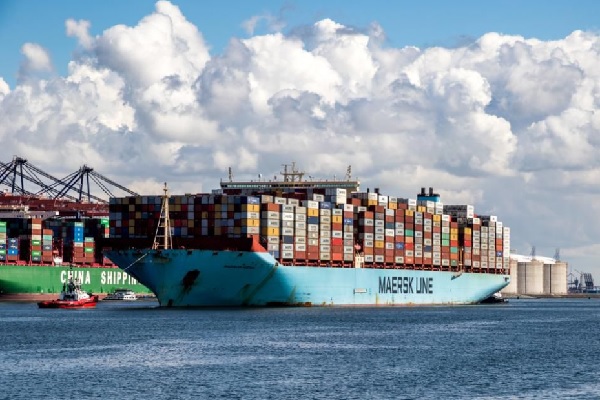Even though there have been momentous developments in the recent history of freight, most commodities are still shipped mostly the same way they have for at least 200 years – by sea and railroads. Indeed, after a relative decline towards the end the 2000’s, rail freight seems to be increasing.
In the European Union (EU), for instance, the amount of weight transported by rail freight steadily expanded from 2010 to 2017. During the period between 2006 and 2017, EU rail freight transport peaked at 438 billion tonne-kilometres in 2007.
And, rail freight transport for 2017 in the EU was estimated at 416 billion tonne-kilometres, up 3.2% over the previous year’s figure of c.403.3 billion tonne-kilometres in the EU’s 28 member states – from Austria to the United Kingdom (U.K).
Similarly, ports are a vital component of the world economy, as they are the entry point for most of the globe’s imports.
In 2016, for example, ports in the United States (U.S.) saw nearly $2.2 trillion dollars of exports leave, while more than $2.7 trillion in imports entered the country. Along with railroads, they comprise a key link in the world’s commodities supply chain.
Railroads are essential for overland transport and are responsible for moving large amounts of freight directly from ships and towards their final destinations. Even so, advances have focused largely on improving physical structures, and not as much on the technological infrastructure that supports the overland shipping economy.
Nevertheless, technology rarely stands still, and especially in an industry so vital to the global economy.
And, as blockchain breaks free of its crypto origins, the commodities trading and shipping world is beginning to recognize and realize technology’s potential, implementing it to great success and with tremendous future potential.
Expediting Movement of Commodities
Despite its essential nature, the American Society of Civil Engineers (ASCE) has noted that America’s railroad network needs an investment of at least $200 billion over the next 15 years to sustain the projected demand long-term. ASCE, which is the nation’s oldest engineering society that was founded in 1852, graded or ranked U.S. rail infrastructure with a C- (C minus).
Back in 2013, the Federal Railroad Administration in the U.S. estimated that Class II and III railroads would only be able to invest $1.6 billion out of a required $6.9 billion over the following five years in order to maintain, modernize and expand capacity.
Ports are in the same boat – forgive the pun – functioning despite infrastructure that is old and cannot quite meet demand. Take the U.K., around 90% of all imports enter through ports.
While these physical improvements are necessary and concerning, technological improvements could make the burden less worrisome, and help mitigate many of the worst issues these vital supply chain cogs face.
One of the biggest ways the industry is seeking to reduce the burden of transportation on ports and railroads is by improving the technology that manages supply chains.
And, one of the biggest issues many train and rail systems encounter is so-called detention dwell, whereby delays in one train leaving or unloading at a station spiral and creates larger problems both for loading and train entries.
In some cases, blockchain technologies could be an ideal solution for detention dwell, as it allows for more immediate information transfer, and smarter decisions based on real-time data.
Indeed, some studies have found that railroads could significantly improve their performance by reducing friction at these transit bottlenecks, as well as facilitating the entry and exit processes for trains thanks to improved data transfers.
New platforms, from the likes of Brisbane-based CommChain, which manages the documentation companies need to ship goods worldwide on blockchain, could reduce the delays caused by missed or late paperwork. Having recently launched a platform the company is seeking to marry and combine the power of blockchain technology with bulk commodity trading.
By transferring the movement of documents to blockchain – aka the distributed ledger – these applications improve the speed of document transfer. It becomes almost immediate and they can clearly establish a chain of custody. And, it has been claimed that by facilitating payments via the CommChain’s network, settlement period can be completed in less than three days.
Faith Dempsey, a co-founder and director of CommChain who is also a founder of TransCoal and TransBulk Logistics in Australia with around 40 years’ experience in exporting coal and mineral worldwide, commenting said: “Not only will this technology assist in reducing the “air-gap” that exists in the payment process from the ‘cutting’ of bills of lading to their delivery in the buyer’s country by an approximately 10 days delivering a significantly reduced payment period, the ‘tokenization’ of the commodity means the product producers can bring liquidity into their businesses at an earlier time in the supply chain.”
Industry experts see blockchain as one of the most revolutionary technologies to change rail freight in decades. In some eyes, most of the industry will likely be on blockchain entirely – or at least partially – within the next decade. That is the boast anyway.
Global advisory firm EY has pointed out that the commodity transaction life cycle needs a substantial number of processes across multiple market participants – even for basic transactions to be completed.
In a report from 2017 published by EY titled “Overview of blockchain for energy and commodity trading” (2017), the firm noted that by applying blockchain technology, the commodity trading arena could reap multiple benefits spanning capital costs, swifter settlements, reduced manual processing and a lesser reliance on multiple systems.
Upgrading Ports’ Commodity Tracking
At ports, the issues are similar though somewhat unique. Many were built for a much smaller workload and have started showing the strain of higher throughput. Others are simply run inefficiently or face the same problems as other links in the supply chain.
Congestion, slow times to move goods in and out of holding points, container management, and more are issues that could be readily solved by technology – but have not yet been fully tackled.
Here, however, blockchain has already started to make an impact. For instance, in Antwerp, one of Belgium’s – and the world’s – largest seaports on the River Scheldt, a trial run has shown the extent to which blockchain can streamline the loading and unloading process.
In some cases, getting a truck to the right container area takes as many as seven complex steps. Blockchain removes the need for most of them by presenting a clear chain of custody and allowing stakeholders to communicate exactly what they need and where it is.
IBM Blockchain
Similarly, IBM – aka “Big Blue” – and the Danish shipping giant Maersk have been hard at work in the past few years creating a blockchain-based system for supply chain management. The project has already on boarded many of Europe’s largest ports of entry, already registering over 230 million shipments and 20 million containers.
IBM, which has have around 1,600 staff working in blockchain and distributed ledger technology (DLT) across all areas and sectors in its IBM Blockchain area, announced in January 2018 that it had forged a global joint venture with business conglomerate A.P. Moller-Maersk Group Maersk with the aim of applying blockchain to “digitize” global trade.
The venture, which as a new company will be headquartered in the New York metropolitan area, named Michael J. White, former president of Maersk Line in North America, as its CEO.
This initiative followed around a month after IBM had announced that together with Walmart, Nasdaq-listed Chinese retailer JD.com and Tsinghua University the parties would collaborate on a food safety alliance in China using blockchain for greater safety and tracking within the food supply chain
Bridget van Kralingen, senior vice president, IBM Global Industries, Solutions and Blockchain, stated at the time: “Our joint venture with Maersk means we can now speed adoption of this exciting technology with the millions of organizations who play vital roles in one of the most complex and important networks in the world, the global supply chain.”
The executive, who and has been listed as one of Fortune Magazine’s 50 Most Powerful Women in Business and holds a Master of Commerce from the University of South Africa, added: “We believe that blockchain will now emerge in this market as the leading way companies seize new untapped economic opportunities.”
On a similar tack, a Russian blockchain project for ports named Edge.Port was reported this February to have estimated that the technology can decrease waiting times for ships and containers at ports from over 4 hours to just 25 minutes, and improve overall port capacity from 3% to 5%.
Improving Infrastructure for Better Global Shipping
Ports and railways are still two of the biggest components of the global commodities trade, and their technological advancement to date has been meagre at best. Even so, the introduction of blockchain and decentralized ledger technology could be a game-changer for both.
By improving communications, chain of custody, and reducing the possibility of fraud and other crimes, technology makes shipping safer and more efficient by rail.
Additionally, the efficiency and streamlining effects the technology has on even the most complex processes – such as releasing cargo to the right companies while managing inventory and space – can result in billions of dollars in savings, as well as more capable global trade. It’s a brave new world for sure.
Note: The author of this article is Roger Aitken.
Source:www.forbes.com/sites/rogeraitken/2019/04/11/blockchain-or-bust-how-this-tech-can-boost-port-rail-logistics-efficiency/#3c3831181edc





